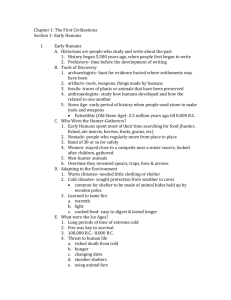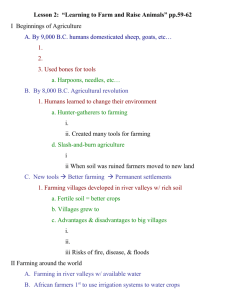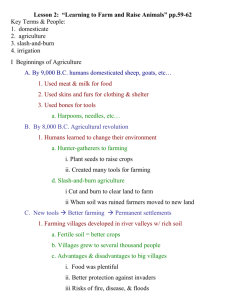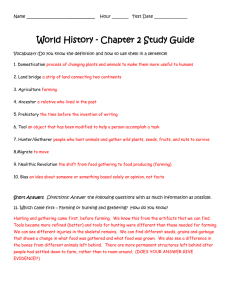Chapter One A Continent of Villages
advertisement
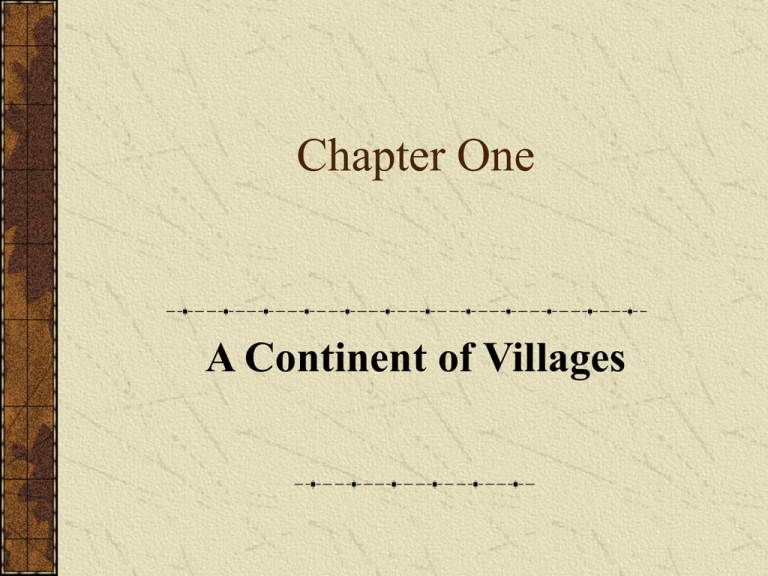
Chapter One A Continent of Villages Part One: Introduction A Continent of Villages What does the chapter title suggest about North American Indian societies before 1500? Chapter Focus Questions Who were the migrants that peopled the Americas? How did native cultures adapt to the regions of North America? How did the development of farming increase the complexity of native societies? What was the nature of Indian culture in the three major regions of European invasion and settlement? Part Two: Cahokia Cahokia An urban complex along the Mississippi that flourished from the tenth to the fourteenth century Populated by about 30,000 people by mid-1200 Farmers with highly productive cultivation techniques Craftsmen producing goods for continent-wide trade Center of long-distance trading system City-state sponsored by tribute and taxation Mounds were monuments to the elite Priests and governors could look down on people Huge temple covering 15 acres and reaching 10 stories high showcased city wealth and power Part Three: Settling the Continent Who Are the Indian People? The name “Indian” came from Christopher Columbus belief he had reached the Indies. Enormously diverse group of people 2,000 separate cultures Several hundred different languages Many different physical characteristics Theories arose over the origins of the Indian peoples. Native societies were the degenerate offspring from a superior Old World culture. Joseph de Acosta believed that since Old World animals were present in the Americas, they must have crossed a land bridge used by humans as well. Migration from Asia Map: Migration Route from Asia to America New genetic research links American Indians and northwest Asians. Beringia land bridge between Siberia and Alaska Glaciers locked up enough water to lower sea levels, creating grasslands 750 miles wide from north to south. Three migrations from Asia beginning about 30,000 years ago Traveled by land (ice-free corridor) and along coast Settlements on Great Plains have been dated as early as 10,000 B.C.E. Clovis: The First American Technology Clovis tradition was a new and powerful technology. More sophisticated style of making fluted blades and lance points. Named for site of first discovery: Clovis, New Mexico Clovis bands were mobile, foraging communities of 30–50 individuals from interrelated families. Clovis bands migrated seasonally to the same hunting camps. Part Four: New Ways of Living on the Land Hunting Traditions Massive climate shift beginning about 13,000 B.C.E. placed stress on big game animals Great Plains hunters concentrated on American bison (buffalo), requiring fast, accurate weapons. Folsom tradition was a refinement of Clovis. Hunters used spear-throwers to hurl lances at bison. Sophisticated hunting techniques included stampeding bison herds over cliffs. Required sophisticated division of labor and knowledge of food preservation techniques Desert Culture Desert Culture was a way of life based on small-game hunting and intensified foraging. Foraging followed seasonal routes. Skills included: producing fiber baskets for collecting; pitch-lined baskets for cooking; nets and traps; and stone tools. Spread to Great Plains and Southwest West coast developed first permanently settled communities in North America Forest Efficiency Eastern North America was a vast forest. Developed during Archaic period and included: small-game hunting; gathering seeds, nuts, roots, and other plants; burning woodlands and prairies to stimulate growth of berries, fruits, and roots; burning created meadows to provide food that attracted grazing animals for hunting; and fishing Populations grew and settlements became permanent. Men and women held different roles. Part Five: The Development of Farming Mexico People living in central Mexico developed farming of maize about 5,000 years ago. Other American crops included potatoes, beans, squash, tomatoes, peppers, avocados, chocolate, and vanilla. Agriculture stimulated sedentary lifestyle and rise of large, urban complexes. Teotihuacan had 200,000 inhabitants. Mesoamerican civilizations were characterized by an elite class of rulers and priests, monumental public works, and systems of mathematics and hieroglyphic writing. Increasing Social Complexity Farming stimulated increasing social complexity. Families were grouped into clans that bound people together into a tribe. Tribes were led by clan leaders of chiefs and advised by councils of elders. Chiefs were responsible for collection, storage, and distribution of food. Gender strictly divided labor. Marriage ties were generally weak. Growing populations required larger food surpluses and led to war. The Resisted Revolution Adoption of farming was a gradual process taking hundreds of years. Climate, abundant food sources, and cultural values sometimes led to rejection of farming. People often adopted farming simply as a way to increase food production. Foraging could provide more varied diet, was less influenced by climate, and required less work. Studies have shown that farmers were more subject to different diseases and famine than foragers. Favorable climate was pivotal to the adoption of farming. The Religions of Foragers and Hunters Foraging and farming shaped religious traditions. The Hunting Tradition was: centered in relationship between hunter and prey; had the vision quest as a ritual; and organized around individual shamans. The Agrarian Tradition was: centered on idea of fertility; employed ritual festivals to mark changing of seasons; and organized into cults and priesthoods. Farmers of the Southwest Farming began to emerge in the Southwest during the first millennium B.C.E. The Mogollon The first to practice settled farming way of life growing maize, beans, and squash Lived in pit houses in permanent villages near streams along the Arizona–New Mexico border from about 250 B.C.E. to C.E. 1450 The Hohokam: Grew maize, beans, squash, tobacco, and cotton Villages in the floodplain of the Salt and Gila rivers between C.E. 300 to 1500 Developed the first irrigation system in America north of Mexico Shared many traits with Mesoamerican civilization. The Anasazis Anasazi farming culture arose on the plateau of Colorado River around Four Corners area where Arizona, Utah, Colorado, and New Mexico meet. Built densely populated, multistoried apartment complexes (pueblos) clustered around kivas Grew high-yield maize in terraced fields irrigated by canals • Supplemented vegetable diet by hunting with bow and arrow Culture consisted of 25,000 communities that extended over area larger than California Declined because of extended drought and arrival of Athapascan migrants, leading to abandonment of Four Corners area. Farmers of the Eastern Woodlands Farming culture in eastern North America was dated from the first appearance of pottery about 3,000 years ago. Woodland culture combined hunting and gathering with farming Sunflowers, small grains, tobacco Developed a complex social structure Adena culture occupied Ohio River basin from before 1000 B.C.E. to about C.E. 250. Established custom of large burial mounds for leaders The Hopewell Culture Hopewell people settled in Ohio-Mississippi Valley between 200 B.C.E. and fifth century C.E. Hopewell culture adopted Adena custom of burial mounds. Mounds became larger and more elaborate Rare and precious artifacts from trade network were included in burial mounds of great leaders Long-distance trade network Obsidian from the Rocky Mountains Copper from the Great Lakes Mica from the Appalachians Shells from the Gulf Coast Mississippian Society Introduction of bow and arrow, development of new maize variety, and switch from digging sticks to hoes were basis of Mississippian culture. Developed sophisticated maize farming Centered around permanent villages on Mississippi River floodplain, with Cahokia as urban center • Linked by river transportation system. Built large effigy earthworks Complex division of labor headed by elite class of rulers • Tasks of preventing local conflict, storing food supplies, and redistribution of food required leadership class with power to command. The Politics of Warfare and Violence The late thirteenth century brought a climate change marked by 150 years of cool, dry weather. Climate change may have caused an increase in violence and social disorder Hunting communities organized small raids on farming communities. Farming communities fought to gain land for cultivation. Highly organized tribal armies developed • The bow and arrow was the deadly weapon of war. • Scalping originated among warring tribes. Eventually, many cities collapsed and people scattered forming small decentralized communities. Part Six: Cultural Regions of North America on the Eve of Colonization The Population of Indian America Map: Indian Settlement before European Colonization The population of the Western Hemisphere in the fifteenth century may have numbered 50 million or more. Population varied by cultural region. Largest populations were centered in Southwest, South, and Northeast--culture areas where first encounters with Europeans occurred. The Southwest Map: Southwestern Indian Groups on the Eve of Colonization Aridity central fact of life in Southwest, though a number of rivers flow out of mountain plateaus. Most peoples practiced dry farming or irrigated agriculture, living in villages. Dispersed settlements separated by as much as a mile Pueblos had a commitment to communal village life Region home to Yuman, Pimas, Pueblos, and most recent arrivals, Athapascans who developed into Navajo and Apaches. The South Map: Southern Indian Groups on the Eve of Colonization Mild climate with short winters and long summers proved ideal for farming. Large populations lived in villages and towns, often ruled by chiefs. Region home to Choctaw, Chickasaw, Creeks, and Cherokees. Many groups decimated by disease following the arrival of Europeans resulted in poor documentation of history The Natchez The Natchez lived in floodplains of lower Mississippi Delta. Class society ruled by “Great Sun” and a small group of nobles ruling the majority Persistent territorial conflict with other confederacies elevated warriors to an honored status. Practiced public torture and human sacrifice of enemies Chiefdoms were unstable, resulting in scattering of people into smaller decentralized communities. The Northeast Maps: “Northeastern Indian Groups on Eve of Colonization” Colder part of eastern woodlands with geography of coastal plains, mountains, rivers, lakes, and valleys. The Iroquois: Lived in present-day Ontario and upstate New York Grew corn, beans, squash,and sunflowers Matrilineal family lineage centered around longhouses Formed confederacy to eliminate warfare The Algonquians: Comprised at least 50 distinct, patrilineal cultures Were organized into bands with loose ethnic affiliation in north Farmed and lived in villages in south Part Seven: Conclusion A Continent of Villages, to 1500 Media: Chronology, Chapter 1
